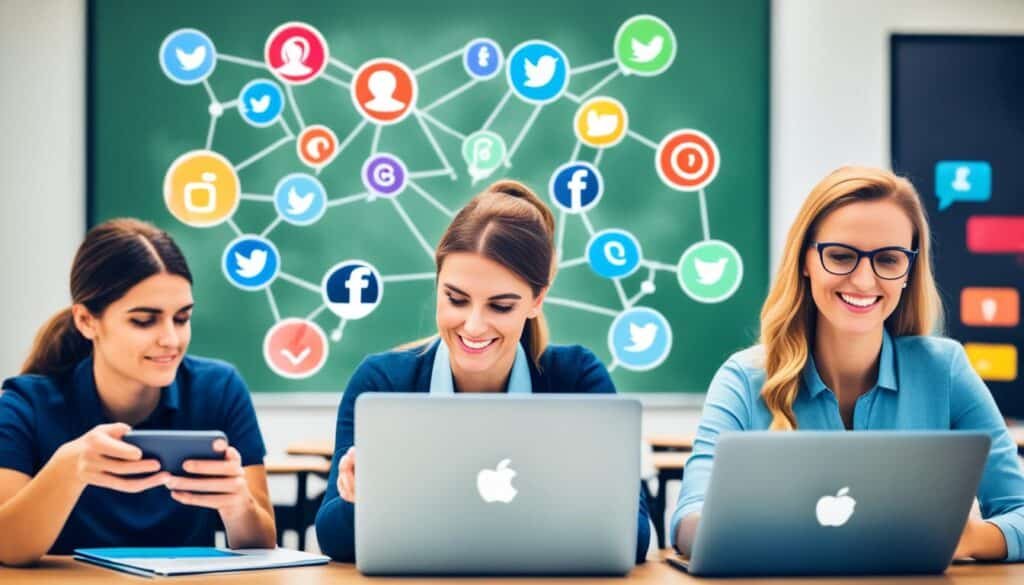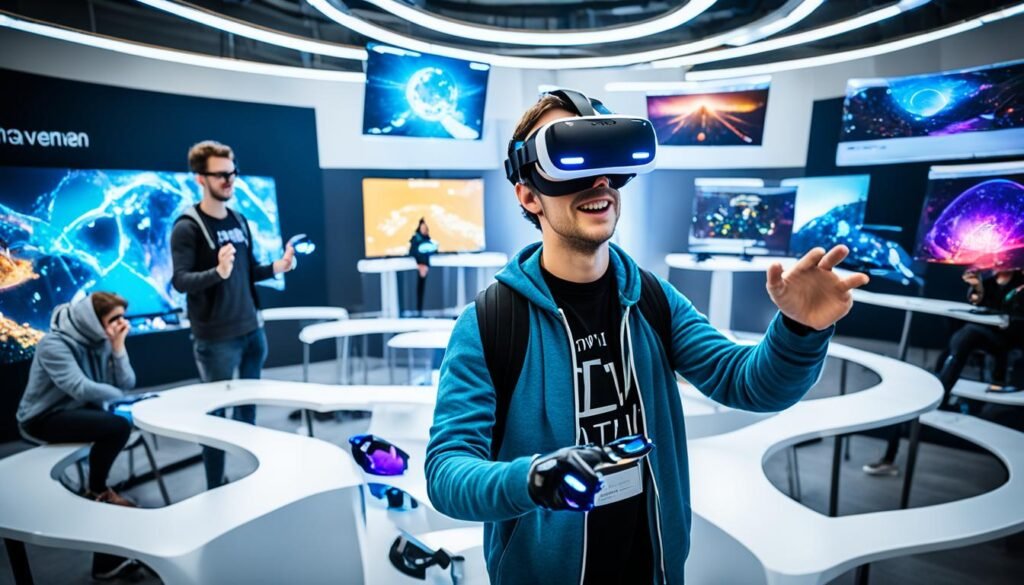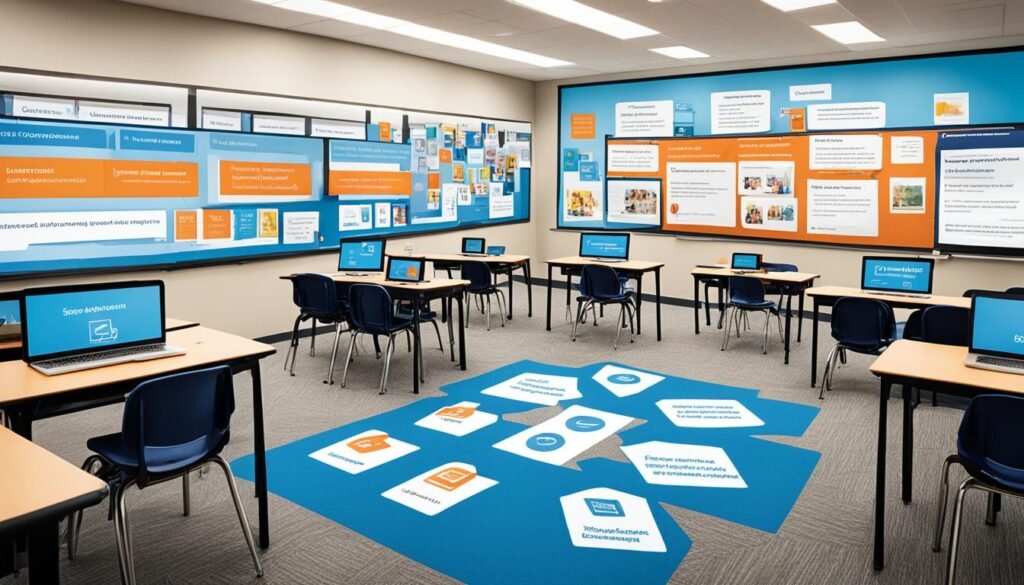Technology Applications In Education is changing every part of our world, and it’s also affecting education. New tech is making lessons more fun and personalized. Things like virtual reality and AI are helping teachers teach better and students learn more.
Studies show that tech in education is a big win. It makes understanding hard stuff easier and helps students remember things better. It also builds skills they’ll need in the future. In short, tech is making 21st-century classrooms more student-friendly.
Virtual and augmented reality bring a wow factor to classrooms. They take students on virtual trips and make abstract ideas real. Now, history comes alive, and biology lessons are a lot more hands-on, all thanks to these tools.
AI and machine learning are also making a big difference. They’re used for grading, making lessons that fit each student, and improving learning materials. This means teachers can help students learn in ways that work best for them. It also helps teachers get better at their jobs by tracking student progress.
Cloud computing is a game-changer too. It lets students learn from anywhere. They can access tons of educational stuff online. This leads to new ways of teaching, where students learn at their own speed. This leaves more class time for fun and teamwork with classmates and teachers.
Adding 3D printing to the mix makes classroom learning more hands-on. It lets students make 3D models of what they’re learning. This kind of learning sticks with students more because it’s fun and interactive.
The tech revolution in education is just beginning. As we keep on, new tech will keep changing how we learn. This means students will get more chances to learn in ways that suit them best. It’s all about making learning more fun and effective in the digital age.
Key Takeaways
- Technology is transforming the education sector, enabling more engaging and personalized learning experiences.
- Virtual reality (VR) and augmented reality (AR) are being integrated into classrooms, allowing students to explore immersive learning environments.
- Artificial intelligence (AI) and machine learning are automating grading, providing personalized feedback, and developing adaptive learning platforms.
- Cloud computing is enabling seamless access to digital educational resources and enabling the flipped classroom model.
- 3D printing is allowing students to bring concepts to life, enhancing hands-on and interactive learning.
Embracing Virtual Reality (VR) in Education
Technology is changing how we learn, and virtual reality (VR) is a big part of this shift. More teachers are using VR to change student learning. By stepping into 3D worlds, students get more involved in learning. This method lets them explore, interact, and understand topics better.
Immersive 3D Learning Experiences
VR in education lets students enter 3D worlds. This makes learning more engaging than traditional methods. For example, students can do experiments with no real lab equipment. They can also visit places from history or literature without leaving their classroom. This way of learning helps them remember what they learn more.
Virtual Field Trips to Inaccessible Places
VR also offers something amazing: the chance to take virtual field trips to places they can’t go in real life. With VR headsets, students can see the bottom of the ocean or walk on another planet. This makes learning not just fun but also very interesting.
Big companies like Google are helping with these new methods. They bring VR experiences to classrooms, letting students learn in exciting new ways. As more schools use VR, we’ll see even more creative ways to learn using this technology.
Leveraging Artificial Intelligence (AI) and Machine Learning

Artificial Intelligence (AI) and Machine Learning (ML) are changing education for the better. They are making learning more effective cutting tedious work.
Automated Grading and Personalized Feedback
AI systems are changing how student work is graded. They can check essays, problem sets, and tests very accurately. This saves teachers time.
With this technology, each student can get advice that suits them. The AI looks at what a student does well, what they need to work on, and then guides them accordingly. This ensures everyone gets the help they need.
Adaptive Learning Platforms
Adaptive learning platforms adjust to each student’s style. Powered by AI and ML, they change the learning content and pace. This makes learning match each student’s skills and needs.
This method is great, especially for those with special needs. It ensures they get the exact help they need to do well. No one is left behind.
AI and ML are not just about making things better for students. They are also helping teachers teach in new, more efficient ways. As these tools get better, they will become key parts of education’s future. Both students and teachers will benefit greatly.
Cloud Computing for Seamless Educational Access

Technology keeps changing education, especially with cloud computing. It’s making it easier for everyone to get to learning tools. This new way of learning online is exciting. It makes learning lively and reachable for both students and teachers.
Centralized Storage for Digital Resources
Schools can store all their lessons and videos in one place with cloud computing. Students can then learn from any place they want, at their own pace. With all materials online, there’s no need for heavy books and trips to the library.
Learning gets much easier like this, encouraging students to explore on their own. They can access their lessons online and learn anytime, anywhere. This is changing the way students learn for the better.
Enabling Flipped Classroom Models
Cloud technology also makes flipped classrooms work well. In this model, students watch their lessons at home. Then, class time is for activities and working together. It makes learning hands-on and fun.
Cloud tools let students talk to their teachers online and join virtual classes. This makes learning very personal and easy. Students can chat, join online classes, and learn in a way that fits them best.
| Cloud-Based Learning Benefits | Traditional Classroom Learning |
|---|---|
|
|
3D Printing: Bringing Concepts to Life

The world of education is changing fast. Thanks to 3D printing, students and teachers can now make 3D models real. This new tech lets them bring concepts to life in exciting ways.
Before, learning was mostly from textbooks. But now, 3D printing in education lets students do hands-on learning. They can create and see 3D models up close. This helps them really grasp engineering and design concepts.
This change is a big deal for college and university students too. They use 3D printing for technology innovations in education. This means design students can make and test their ideas. It gets them ready for real job challenges.
| Applications of 3D Printing in Education | Benefits |
|---|---|
| Concept Visualization | Allows students to create physical models of complex ideas, enhancing their understanding |
| Hands-on Learning | Encourages active engagement and interaction with course materials |
| Prototyping and Design | Enables students to iterate and refine their designs in an iterative manner |
| Interactive Learning | Fosters a more immersive and engaging learning experience for students |
The education industry is really taking to 3D printing. This is changing how students learn. We’re moving towards a future where technology innovations in education are essential for success.
Incorporating Social Media in Educational Institutions

Educational institutions are now using social media’s power. They have seen its big role and use it to connect people everywhere. The idea of some sites started at colleges. Now, schools worldwide use social media in education to break down the distance between people. This helps global collaboration happen among students and teachers.
Connecting Students and Educators Globally
Thanks to educational social networks, schools can now reach out worldwide. Even if separated by oceans, they can share ideas and insights. And it’s not just about talking but also about creating strong student-educator connections.
Facilitating Collaborations and Idea Exchange
Students from different places are coming together through social media. They share their thoughts and work on projects. These collaborations can lead to new technology innovations in education.
Biometric Systems for Attendance and Security

Biometric systems are changing how schools track attendance and keep students safe. They use facial recognition, fingerprints, and eye-tracking. This changes how schools watch over students and manage school resources.
Facial Recognition and Fingerprint Scanners
Now, facial recognition and fingerprint scanners are trusted ways to know when students come and go. They make it easy for schools to record when students are in class. This helps lower skipping classes. Also, these technologies can keep track of who’s using school stuff like library books or sports gear. This promotes students to be more responsible and respectful.
Monitoring Student Engagement with Eye-Tracking
Biometric tools do more than help with attendance. They also check how involved students are in lessons. Eye-tracking, for example, lets teachers see where students focus. This shows what they find hard or easy. With this info, teachers can help students better. It makes learning more personalized and effective.
Technology Applications In Education

The internet has made tech advancements in education speed up. Companies design laptops and tablets just for learning. Mobile learning and educational apps are now common, making classes better.
Mobile Learning and Educational Apps
Some schools have chosen to use mobile devices instead of banning them. They’re using educational apps to cater to different learning styles. This also helps with personalized learning. Students can now learn, share ideas, and do activities on their devices wherever they are.
Interactive Whiteboards and Classroom Automation
Education is also welcoming tools like interactive whiteboards and classroom automation. Teachers can show videos and have students work together in real-time. These tools make teaching more fun and productive for everyone.
Gamification: Making Learning Engaging

Gamification changes how we learn, making it more fun and effective. In education, it adds game elements like points and challenges. This makes learning not only more enjoyable but also boosts how much we remember and learn.
Gamified Learning Platforms
Now, there are gamified learning platforms that are becoming popular. They offer fun and interactive ways to learn. They use game tactics to enhance the learning process. This means students find studying more interesting and are keener to join in.
Leaderboards, Badges, and Challenges
Leaderboards, badges, and challenges are also making a big difference. They inspire students to do their best by offering rewards and a sense of accomplishment. This approach makes learning not just fun but measurable. Educators can see how well students are doing and help them where needed.
The Metaverse and Immersive Learning

Technology is changing how we learn, especially through the metaverse. It’s a new, exciting way for people to learn by experiencing things virtually. This new way is great for job training, letting employees practice in real-like situations online.
Virtual Corporate Training Spaces
In the metaverse, employees can do a lot. They can have mock customer meetings, learn crisis management in virtual boardrooms, and practice work-related tasks in 3D. This immersive approach to learning is very effective. Learners get to tackle real problems in a risk-free place. They also work together with colleagues worldwide, making learning more social.
AI Companions for Personalized Guidance
AI companions are another cool thing in the metaverse. They offer customized help and advice to every learner. Imagine having a digital buddy who teaches you at your own speed and style. This is a great use of AI to make learning personal and fun for everyone.
Blended Learning: Combining Online and Classroom

In today’s world, the way we learn is changing. Blended learning mixes online learning with traditional classes. This way of learning helps students use digital tools well and actively take part in their education. It makes learning more involving for everyone.
Harnessing Digital Tools and Resources
Blended learning lets students make the most of technology. They can find lots of online resources and digital content to study with. This means every student can learn at their own speed and get involved with lessons in a fun way.
Fostering Collaboration and Active Learning
This learning method also focuses on working together and staying active in learning. Students share their thoughts and work together, both face-to-face and through online tools. It not only helps them remember what they’ve learned better but also gets them ready for tech-based jobs in the future.
| Key Benefits of Blended Learning | Blended Learning vs. Traditional Classroom |
|---|---|
|
|
Conclusion
The way we learn has drastically changed due to new technology. We now have amazing tools like Virtual Reality (VR) and AI. These let us learn in exciting new ways.
Thanks to cloud computing, students everywhere can easily access a ton of digital info. This helps them learn and work together with kids from different parts of the globe. 3D printing is also making it easier for students to understand complex ideas.
Social media, biometrics, and games are also making learning more fun and secure. Now, with the upcoming metaverse, learning could get even more personal and immersive. This shows us how important technology is in creating our educational future.
By using these new tech tools, schools are preparing students well for the future. This means they’ll have the skills they need to succeed in our ever-changing world.
FAQs
Q: What is educational technology and why is it important in modern education?
A: Educational technology refers to the use of technology tools and resources to enhance teaching and learning experiences in the classroom. It is important in modern education as it enables interactive and engaging lessons, access to a vast amount of educational resources, and prepares students for a technology-driven world.
Q: How does technology benefit students in their learning process?
A: Technology benefits students by providing personalized learning experiences tailored to their individual learning styles, improving collaboration and communication skills, increasing engagement and motivation, and offering access to a wide range of educational materials and resources.
Q: What are some examples of technology used in education today?
A: Some examples of technology used in education today include learning management systems, online collaboration tools, educational apps and games, virtual and augmented reality tools, interactive whiteboards, and digital textbooks.
Q: How does technology help teachers in facilitating the learning process?
A: Technology helps teachers by providing tools for creating interactive lessons, assessing student progress and understanding, facilitating communication with parents and students, automating administrative tasks, and personalizing instruction to meet the diverse needs of students.
Q: What are the advantages of distance learning through technology?
A: The advantages of distance learning through technology include increased accessibility to education for students in remote areas, flexibility in scheduling and pacing of learning, cost-effectiveness, and the ability to learn from anywhere with an internet connection.
Q: How can technology be integrated effectively in the traditional classroom setting?
A: Technology can be integrated effectively in the traditional classroom setting by training teachers on how to use technology tools, aligning technology use with learning objectives, providing access to devices and resources, and encouraging collaborative and interactive learning experiences.
Q: What is the future of educational technology and its impact on the education system?
A: The future of educational technology is likely to involve more personalized and adaptive learning experiences, increased use of artificial intelligence and machine learning, integration of immersive technologies like virtual reality, and a shift towards more blended and online learning environments.




